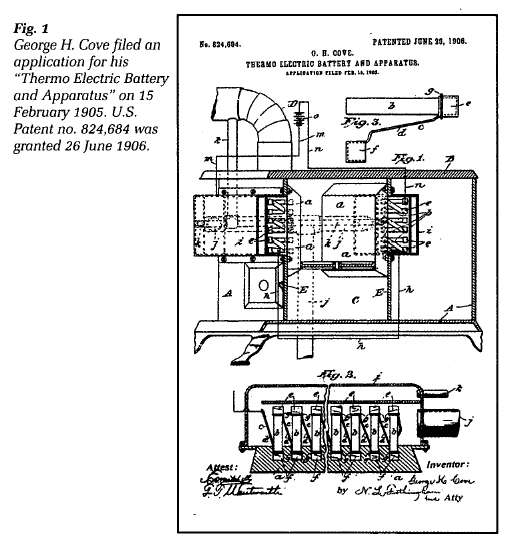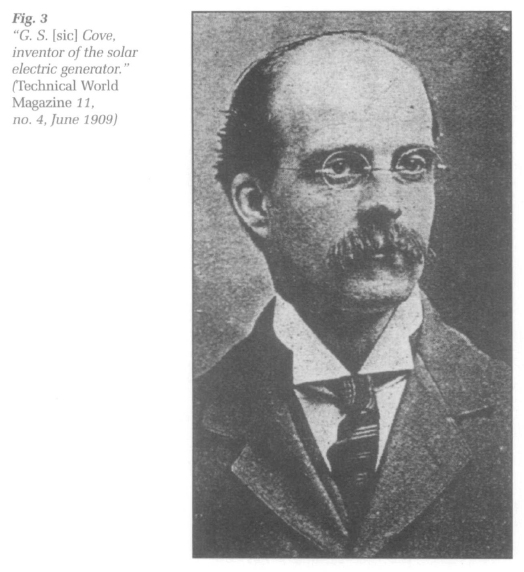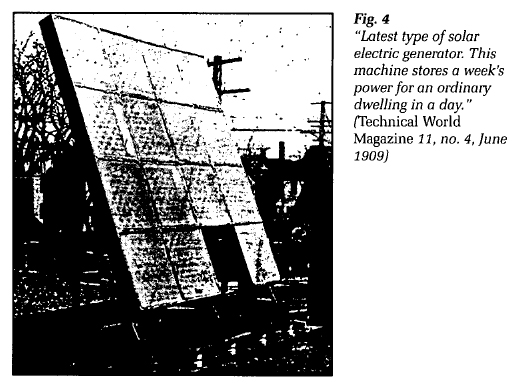Research Reports / Rapports de recherche
George Cove's Solar Energy Device1
1 On 15 February 1905, George H. Cove, an inventor from Nova Scotia, filed a U.S. patent (no. 824,684) for generating electricity from heat differentials in a simple metal alloy. The patent was granted in 1906. The device described in Cove's 1906 patent converted heat from a wood stove to electricity. Cove also used arrays of such devices in solar panels to generate electricity for household use. Working prototypes of Cove's solar electric generator were described in an article by Winthrop Packard in a 1909 issue of The Technical World Magazine:
2 Cove's device was a sort of thermocouple, and thus not based on newly-discovered natural processes or scientific principles. In the patent application the device was described as follows:
 Display large image of Figure 1
Display large image of Figure 13 Cove's attempt to produce and market his solar energy device failed. In this paper, the mysterious circumstances surrounding this failure will be used to explore different theories of technological development.
4 Little is known of Cove's life. He was born in Amherst, Nova Scotia, in 1863 or 1864. His mother, Ann, was also born in Nova Scotia, and her parents were from Ireland. According to the Amherst census of 1871, Ann was a "recent widow," aged forty-three, with four children: George, age eight, his older brother, age twelve, and two younger sisters. Her religion was listed as Presbyterian. George, whose middle name may have been Howard, was described as attending school.3
5 At some point, Ann married Joseph Cove, a Nova Scotia-born inventor who worked at a local trunk and coffin factory. Joseph patented "many mechanical devices which are in use at the present day, some of these being important in the flour making establishments of the West." As well, he was granted a patent for a clothes dryer on 5 March 1870.4 He apparently suffered a disabling stroke in 1891.5
6 In the 1891 Amherst census, George H. Cove, age 27, and his widowed mother, age 64, are listed as lodging with Alex Bonnyman.6
7 In the Amherst Daily News of 16 December 1895, Cove's age is given as 25. He is described as working on a steam engine without electricity, and on "a piano that will reproduce any music ever played by turning on an electric current no matter how many years elapsed since the original playing." In August 1896, Cove made a trip to Saint John, New Brunswick, regarding one of his inventions.7
8 Cove apparently became blind in 1898 from "over-straining" his eyes while working on his "electric piano attachment."8 His blindness was apparently temporary, and there are no further references to it.
9 Cove built his solar electric generator in 1904-05. In the summer of 1905, he placed a model in the Metropole Building in Halifax, Nova Scotia, and sent a description of the device to a group of American investors. They sent an "expert" to examine the model in Halifax, and financed a laboratory and plant for Cove in Somerville, Mass.9 Cove is listed in the 1906-07 Boston City Directory as living at 27 Copeland Street in Roxbury, Mass. He is also listed in the 1909 Somerville, Mass., City Directory.
10 Cove patented a "tide water power system" in 1906, which was tested at the Bay of Fundy in 1909.10 He received a "gold medal" for this invention from the Canadian government.11
11 The foregoing account is incomplete and inconsistent, partly because there was more than one George Cove living in Amherst when the inventor lived there. In the late nineteenth century, the Cove family had many branches in Amherst, and their descendants still live there.
12 In 1909-10, Cove and his backers were raising capital in New York in order to produce and market solar electric generators. Cove maintained a workshop and laboratory in New York at 118 Maiden Lane. Shares in his company were sold from an office on Wall Street. Apparently, few shares were sold, and Cove's machine was not widely adopted. By 1911 his business was failing. This was probably related to the publicity surrounding his alleged kidnapping in October 1909. According to a report in The New York Herald on 19 October 1909, Cove's kidnappers offered him $25 000 and a furnished house if he would cease promoting his solar electric generator. When Cove refused, the kidnappers released him at the Bronx Zoo. According to The World newspaper (19 October 1909), Cove accused one of his former backers, Frederick W. Huestis, of organizing the kidnapping. Huestis denied this, and claimed that Cove himself had arranged the incident as a publicity stunt. Huestis also claimed to have withdrawn financial backing from Cove upon discovering that the solar electric generator didn't work. The police apparently believed Huestis, and dismissed Cove's kidnapping as a hoax.
13 Presumably, this incident led to the demise of Cove's Sun Electric Generator Corporation which, according to Trow's Co-Partnership and Corporate Directory for New York, 1910—11, was capitalized at $5 million. The 1911-12 Directory had "no information" about Cove's corporation, and it was not listed in later editions.
14 Did Cove's solar electric generator actually work? In June 1994, Professor Gertrude Rempfer (Department of Physics, Portland State University) examined Cove's 1906 patent and concluded that, "In principle, [Cove's method] is certainly one way of obtaining useful work from temperature differences. One would have to investigate more deeply to determine how practical this method would be as a power source."12
 Display large image of Figure 2
Display large image of Figure 215 Perhaps Huestis told newspaper reporters that Cove's device was "no good" because it was not a practical power source. Engineering News, a New York-based periodical, published two articles in 1909 on experiments with generation of electricity from solar power. According to one of these articles, "...until some revolutionary advance is made in the means of storing energy, no sun motor can be a commercial success in any humid climate where the sky is frequently covered up with clouds..."13 Cove's device certainly did not represent such an advance, and his device was not described in either article.
16 It is also possible that Cove's device was a practical power source, despite the limitations of contemporary energy storage systems. If so, perhaps Huestis told the press that the device was a failure because he had powerful backers whose interests were threatened by the solar electric generator. These may have included the Edison Electric Illuminating Company of New York. Widespread use of the solar electric generator might well have reduced growing demand for Edison's coal and oil-fired generating stations.
 Display large image of Figure 3
Display large image of Figure 317 The interests of the Standard Oil Company were also threatened by Cove's invention. Standard provided much of the coal oil (that is, kerosene) that was used for lamps throughout the United States. In areas where kerosene lamps were being replaced by electric lighting, Standard provided oil for electric generating stations. Widespread use of the solar electric generator might well have reduced demand for kerosene and oil-fired electricity generation.
18 The unscrupulous practices that Edison and Standard used against their competitors are well-documented. When the Edison Company was trying to prevent the introduction of alternating current systems by Westinghouse, it staged public electrocutions of stray dogs in order to show that alternating current was "unsafe."14 Ronald Clark writes,
Standard Oil's ruthless drive to gain monopoly control of oil production and distribution by absorbing or ruining its competitors led to the first U.S. anti-trust legislation in 1889.16
19 Although Cove's name does not appear in the finding aids of the Edison National Historic Site at West Orange, N.J., the possibility that Edison conspired against Cove should not be entirely ruled out in light of Edison's unscrupulous behaviour toward other competitors. The threat to monopoly represented by the solar electric generator was recognized by Winthrop Packard in his 1909 article on Cove:
 Display large image of Figure 4
Display large image of Figure 4 Display large image of Figure 5
Display large image of Figure 520 Packard also argued that dwindling supplies of oil would compel widespread use of Cove's invention.18 Cove himself used a similar argument: "Everybody knows that the amount of the natural power that is going to waste every day is inconceivable. Experts declare that the coal deposits and oil wells of the United States will supply only so few more generations, so that the natural powers must be utilized in order to preserve our other natural resources."19 Daniel Yergin has shown that such recurrent predictions have so far proved to be unfounded.20
21 Cove's invention was not taken up by socialist and anarchist movements as a weapon in their struggle against monopoly capital. The solar electric generator did not figure explicitly in early twentieth-century visions of a socialist, communist, or anarcho-syndicalist future. Similarly, environmentalists in 1910 did not recognize the possible dangers posed by development of a global, fossil-fuelled energy base, or the potential of the solar electric generator for inhibiting or diverting this development.
22 It should be noted, however, that the demise of Cove's device may not have resulted entirely from conspiracy or indifference. Thomas Edison spent a great deal of time and money between 1900 and 1914 developing and producing electric batteries. Had he not been exclusively concerned with finding a practical way of using batteries to power automobiles,21 Edison might have seen the commercial potential of marketing a combination of the Edison Battery and Cove's solar electric generator for domestic use. Widespread adoption of such a system might have partially pre-empted increasing dependence on electricity generated by burning fossil fuels.
23 If Cove's invention was, in fact, suppressed by Edison and/or Standard Oil, this would support the Marxist view that the direction of technological development is mainly determined by the interests of capitalists. They will promote technologies that increase their wealth and power, and suppress technologies that don't. For example,
The late Marxist sociologist, Bernhard Stern, also provided interesting examples of suppression of technological innovations by large American corporations.23
24 While Marxists argue that major historical events, including technological developments, are largely determined by class interest and class struggle, the contemporary economist, Brian Arthur, argues that, in some cases, major directions of technological development can occur almost by accident:
25 This seems an appropriate characterization of the development of solar and fossil-fuelled energy, from the time of Cove's device to the present. Even with the low prices of fossil-fuel energy in the early twentieth century, there might have been demand for Cove's device in remote areas, where regular deliveries of coal or oil were costly. People in such areas, particularly in developing countries, are major buyers of solar energy technologies today.25 In 1909, Cove's device may have been "shut out" simply because oil and coal-fired electricity generation already dominated the market.
26 Even though there may have been a market for an Edison battery charged by Cove's device, Edison was perhaps already too committed to tapping the potentially huge market for electric cars to collaborate in projects with Cove or other manufacturers of renewable energy technologies which had, at best, minor market potential. Although conspiracy does not enter into this scenario, a drive to maximize profit is central to it. This, of course, is consistent with a Marxist perspective.
27 Although there was a significant literature of technologically-based Utopias in the late nineteenth and early twentieth centuries, none of them mentioned Cove's device, and few served as models for Utopian experiments.26
28 Contemporary opportunities for use of renewable energy technologies seem to parallel those presented by George Cove's solar electric generator some eighty years ago. Cove's device represented a potential source of energy for Utopian experimentation, and an alternative to a global fossil-fuelled energy base. But the world went in a different direction, possibly because powerful forces wished it so.
29 Contemporary technologies have again presented us with alternatives to fossil fuels. And powerful forces wish to preserve the status quo. For example, two of the most outspoken critics of theories of human-induced global climate change are Dr Robert Balling, Jr, of Arizona State University, and Dr Patrick Michaels of the University of Virginia, who have, respectively, received over $311 000 and $167 000 over the last four years from the British Coal Corporation, the German Coal Mining Association, Cyprus Minerals, and the Government of Kuwait.27 This is part of a public relations campaign sponsored by the fossil fuel industry to "reposition global warming as theory (not fact)." The conservative George C. Marshall Institute publishes unrefereed articles by the well-known astronomer, Dr Sallie Baliunas, to discredit scientific warnings of global climate change.28
30 But the stakes in the battle between fossil-fuelled and renewable energy sources are now much higher than they were in 1909. This time, widespread deployment of renewable energy technologies may be necessary to save humanity from environmental disaster.
A note on thermocouples
31 The devices designed by Cove are thermopiles, that is, a number of thermocouples (though he does not appear to have referred to them as such) connected in series to produce an electric current.
32 The principle of the thermocouple was discovered in 1821 by Thomas Seebeck when he noted that, in a circuit of two dissimilar metals and where one of the junctions is at a different temperature than the other, an electric current is induced. In 1826 Antoine César Becquerel attempted to use a thermocouple for temperature measurement. Indeed, that is still the primary use of these simple devices, which can measure differences on the order of one millionth of a degree.
33 Cove noted that, using such thermopiles, electrical power could be generated and stored in batteries for later use. He spent a number of years perfecting devices for use as solar energy generators and for use with kitchen stoves. His U.S. patent (1906, no. 824,684) describes a unit for a wood burning stove. By this time, he had solved the problems of the choice of alloys, physical connections of the junctions, insulating materials to thermally isolate the end of the rods, and a strategy for air cooling to increase efficiency.
34 Cove also developed a solar unit that used the same rod and cap design. However, in these he substituted the fire brick and asbestos insulating material for one based on asphalt that, due to the dark surface, would have increased the temperature and, in turn, the efficiency of the junctions. The rods were 3 inches (7.5 centimetres) long, approximately 1/3 inch (0.8 centimetres) in diameter and made of German silver (an alloy of copper, zinc and nickel). These rods were electrically connected by a one-piece assembly that had a cap on each end to connect adjacent hot and cold ends of the rods. The caps were tightly fitted and then further bound to the rods to maintain good electrical contact despite large temperature variations. Cove found that alternating the connecting assemblies between German silver and copper improved the efficiency. In fact, he was adding an additional thermal junction for every two rods. It is worth nothing that voltages generated at each junction are additive, which allowed Cove's electric generating apparatus to work.
35 What makes thermocouples function is the temperature difference between the two junctions. The greater the difference, the greater the voltage and power produced. In the patent description, Cove stated that the six-rod stove unit produced three volts and three amperes of current (that is, nine watts of power or about half the output of a typical 15-watt oven light bulb). Unfortunately, we do not know the typical output of the solar version in which he had 16 panes each with 61 sunward facing junctions. The nine-watt output of the stove unit seems excessively optimistic but even a small current over extended periods can be used to charge a battery.
36 In addition to temperature difference, the output of a thermocouple is dependent on the surface area of the contact points — Cove made his with contact areas that were orders of magnitude larger than modern temperature sensitive devices, in which tiny contact areas yield lower output but respond to small temperature changes very rapidly and precisely.
Curator, Physical Sciences and Space
National Museum of Science and Technology